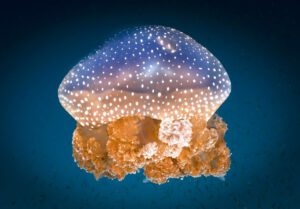Dive Site Directory
Similan and Surin Islands, South Andaman and Myanmar
Similan and Surin Islands
The above water scenery will provide stunningly beautiful white sandy beaches with small forested areas. Dive some of the following sites; Boulder City, Sharkfin Reef, Anita’s Reef, and Three Trees.

Under the surface, you may see Leopard (zebra) shark, blue spotted stingrays, clown triggerfish, rabbit fish, scorpion fish, snappers, emperor fish, giant trevally and angelfish. The coral gardens, bommies, and boulder formations are wonderful to dive.
Elephant Head Rock, visible from the surface, is the biggest pinnacle in the Similans and has some fantastic swim-throughs. Whitetip reef sharks, batfish, trevally and barracuda can often be seen
on the perimeter of the boulders. If you look closely in the cracks and in the rubble you can see smashing mantis shrimp, porcelain crab, moray eels and cleaner shrimp.
There are also sites dominated by huge granite boulders such as Deep Six, Christmas Point, and North Point where you can see white tip reef sharks, schooling giant trevally, and schools of neon fusiliers.
Koh Bon
This is generally the most likely place to see manta rays on our Similans itinerary. You are also likely to see Napoleon wrasse, sweetlips, octopus, bluefin trevally, giant moray eels, great barracudas, fire dart goby, spiny lobster, and nudibranchs of many types. The dive sites vary from wall diving to gently sloping reefs and from submerged boulders to coral gardens.
Diving on the West Ridge can be an adrenaline-filled drift, with amazing views, while the North Reef is a gentler experience over a hard coral garden.
Koh Tachai
This island is famous for its pinnacle dive site, known by many as Twin Peaks, as well as more relaxed reef diving on the North Reef and South Reef. Normally, turtles, barracuda, pipefish, and nudibranchs can be found here. There is also a chance to see bigger species in this area like manta rays and whale sharks, especially from late January until April.
Richelieu Rock
This limestone pinnacle was named after former Danish Naval Officer, Andreas Richelieu, who eventually became the only foreign-born commander-in-chief of the Royal Thai Navy to date, appointed by King Chulalongkorn. One of Richelieu’s tasks was to modernise the outdated Navy charts. As he had become such an influential and important figure, this potentially hazardous-to-ships rock that poked out from sea at low tide, east of the Surin Islands, was eventually named after him.
Barely breaking the surface at low tide, this horseshoe-shaped outcropping slopes steeply to a sandy bottom at 18 to 35 meters (60-120 Ft). This site offers great diversity for such a small and isolated spot. It also offers excellent multi-level diving and, because it’s a high-profile reef, there are always sheltered areas to hide from the current.
The marine life is prolific and includes amongst, many other things; pharaoh cuttlefish, large octopuses, all 5 varieties of anemone fish of the Andaman Sea, a variety of moray eels, ornate ghost pipefish, smashing mantis shrimps, harlequin shrimps, tigertail seahorses, Spanish mackerel, frogfish, many schooling snappers and occasional sightings of manta rays and whale sharks.
Surin Islands
The topside scenery of Koh Surin, with evergreen forests, mangroves, and small beaches, surpasses even that of the picturesque Similan Islands.
Underwater the reefs of Surin offer some of the greatest hard coral diversity in Thailand.
Across sites like Torinla Pinnacle, Hin Kong, and Turtle Ledges you are likely to see Napoleon wrasse, yellow-masked angelfish, bumphead parrotfish, tomato anemonefish and barramundi, as well as lots of turtles that still come ashore in this area to lay their eggs.
Due to the remoteness, not many liveaboard boats visit these islands and you will be able to enjoy the dive sites without sharing them with tourist hordes.
Khao Lak Wrecks
Before disembarking in Khao Lak on some trips, if conditions and timing are favourable, there is a choice of easily diveable wrecks between the Similan Islands and the port of Tap Lamu. The Boonsung and The Premchai are old tin miners that were sunk in the 1990s and are a treat for underwater photographers as well as lovers of life of all kinds!
Only in 18m of water, they are covered in nudibranchs and various kinds of shrimps. Many quite unusual honeycomb morays also made these wrecks home. There are also huge numbers of schooling fish as well as rays and sharks that can occasionally be seen.
Southern Thailand
Koh Lipe
This beautiful pristine island is near Langkawi island and the Malaysian border with some amazing dive sites such as Stonehenge and 8 Mile Rock.
Stonehenge is a vibrant pinnacle densely covered with colorful soft corals. Look out in the blue for Schools of barracuda, giant trevallies, and yellow snappers. Smaller creatures include seahorses, a variety of shrimp & crabs as well as Nudibranchs. Find the masters of camouflage: stonefish or scorpionfish. As this site is very exposed, strong currents are common and can be expected. It also means that diving Stonehenge, as well as 8 Mile Rock (below), depends entirely on local weather conditions on the day. Many other dive sites are also available if conditions do not permit it.
8 Mile Rock is a world-class submerged pinnacle located approximately 8 miles south of Koh Lipe. Many a large pelagic can be spotted cruising by. Manta and eagle rays are among the
main suspects. Other highlights include leopard sharks, giant barracudas and big groupers. If we get really lucky we may even be graced by the presence of a whale shark during the dive. This pinnacle reaches up from the ocean floor at about 50m to 15m below the surface.
It is truly a soft coral paradise, covered in purples, blues and red soft tree corals everywhere. A variety of reef species are found here in great abundance and size.
Koh Haa
Possibly some of the most underrated diving in the whole of Thailand, Moo Koh Haa (literally ‘five island group’) sits almost halfway between Hin Daeng and Phi Phi and is part of the Koh
Lanta National Marine Park. There are actually several dive sites around Ko Haa, the highlights are Koh Haa Lagoon, Ko Haa Neua, and Ko Haa Yai.
Around these amazing islands, you will find pinnacles, walls, boulders, caverns, and swim-throughs, it is magical diving come to life. Ko Haa lagoon is ideal for night dives, and snorkeling, while The Chimney and The Cathedral offer diving not found on other Thailand liveaboard itineraries; with caverns, swim-throughs, and chambers scattered throughout the sites.
Ko Haa has varied marine life too, with ornate ghost pipefish, morays eels, octopus, hawksbill turtles, sea horses, marble rays, and sometimes even leopard sharks.
Hin Daeng & Hin Muang
These two sites are pinnacles (translating directly as Red Rock and Purple Rock) out in the open ocean, reaching down to over 70m, and are best known for manta ray and whale shark encounters. Whether these are sighted or not, the sites also offer an enormous amount of varied life from giant moray eels, pharaoh cuttlefish, schooling rainbow runners and snappers, barracudas, groupers, fusiliers to bluefin trevally.
On the pinnacles, there are fields of Magnificent Anemones, walls of Hematypic soft corals, and huge gorgonian sea fans. Almost perpetually good visibility and dramatic topography combined with huge fish numbers make for excellent liveaboard diving.
King Cruiser
The King Cruiser was a car ferry that used to travel between Phi Phi and Phuket. In 1997, ‘the cruiser’ hit Anemone Reef on her crossing and sank a short distance away. Thankfully, no lives were lost, but divers were left with a great wreck dive!
While she has largely broken up now, she is covered with soft corals and hides a few wonderful gems, as well as being home to several large schools of snappers. While currents can be strong and visibility sometimes challenging, this is a great site to dive as part of an Advanced Open Water course.
Shark Point and Anemone Reef
These pinnacles are part of the same reef system and are only a very short distance apart from one another. Both sites are covered with colorful soft corals and anemones with a variety of fish to suit all divers, from barracuda to seahorses an interesting variety of sea life can be found.
Koh Doc Mai
“Flower Island” is a tiny slice of sheer rock located between Shark Point and Phuket; although it is tiny dives here will always provide divers with a pleasant surprise of underwater life. From Ghost pipe fish to schooling snappers, frogfish, and the occasional bamboo shark there is never a dull moment.
Racha Yai & Racha Noi
Racha Yai is an excellent trip for beginners and those that have not dived for a while. Indeed for any guests aboard carrying out Advanced Open Water courses on-board, Racha Yai offers the perfect opportunity for course dives, with sloping hard coral reefs, white sandy bottoms and a choice of wrecks on the west coast.
Racha Noi has some of the best visibility of all sites in the area. Often described as a ‘mini Similans’ the granite boulder topography is also unique compared to other sites. It offers a choice of hard coral reefs, boulders with large swim-throughs, and the beautiful pinnacle on the south point of this island. Strong currents can make the southern sites challenging, however, with a year-round chance to see manta rays, it is worth the effort to dive here.
Myanmar
